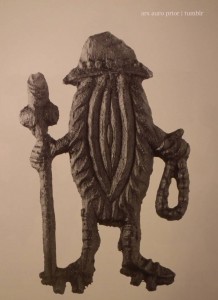In a recent post, W&M contributor Tracy Barrett mentioned in passing the pewter badges worn in the hat during the Middle Ages, and in a moment of recognition I felt compelled to respond with my favourite one, showing a vulva wearing a jaunty pilgrim’s hat. I found out about these tiny objects when I was at an academic conference on the history of the penis (my mother never quite believes the things I get involved in…) held at the wonderful Italian town of Massa Marittima. One of the speakers was Malcolm Jones, who has worked on medieval pilgrimage and talked about these pewter badges as souvenirs. In his book The Secret Middle Ages, Malcolm looks at the various designs of the badges, and suggests that this one is making a joke about the real reason why women go on pilgrimage – it’s to get away from home and have some fun. Rather like going to the Costa del Sol today. Sort of.
 The badges are striking because they are so tiny, so fragile, and could so easily have become an aspect of medieval life that was lost to us. In fact, many thousands have been found, with Amsterdam and Rotterdam being associated with particularly large collections, but they are still being studied, catalogued – and understood. They were cheap, mass-produced, items, and they could have been used as presents from someone on his or her return from a pilgrimage, or ways of signalling one’s political allegiance. Some have images from folk tales so they give us an idea of what stories were being told when they were made and sold. They could be placed over the bed, or kept beside it, to fend off disease or enhance fertility. Many have been found near rivers – deposited there in thanksgiving for a safe passage? The erotic ones mostly date from the end of the fourteenth century or the beginning of the fifteenth century; as well as the vulva, they feature the penis having its own fun and games. Scholars have speculated about whether wearing one of these badges is a sign that the wearer is available for a sexual encounter. It’s difficult to know, as there is not much written about them in literary sources. But this is why they are so interesting – they give us another angle on the people of the middle ages.
The badges are striking because they are so tiny, so fragile, and could so easily have become an aspect of medieval life that was lost to us. In fact, many thousands have been found, with Amsterdam and Rotterdam being associated with particularly large collections, but they are still being studied, catalogued – and understood. They were cheap, mass-produced, items, and they could have been used as presents from someone on his or her return from a pilgrimage, or ways of signalling one’s political allegiance. Some have images from folk tales so they give us an idea of what stories were being told when they were made and sold. They could be placed over the bed, or kept beside it, to fend off disease or enhance fertility. Many have been found near rivers – deposited there in thanksgiving for a safe passage? The erotic ones mostly date from the end of the fourteenth century or the beginning of the fifteenth century; as well as the vulva, they feature the penis having its own fun and games. Scholars have speculated about whether wearing one of these badges is a sign that the wearer is available for a sexual encounter. It’s difficult to know, as there is not much written about them in literary sources. But this is why they are so interesting – they give us another angle on the people of the middle ages.
And Massa Marittima was chosen to host this conference because of a fresco found there in 1999. Probably dating to 1265, this shows a ‘penis tree’. I know – not exactly a familiar concept! Women are shown collecting the penises dangling from the tree, and in one case fighting over one. The fresco was associated with a set of fountains, but George Ferzoco has argued that this is not about fertility and the life-giving powers of various fluids – instead, he reckons, the image is part of a political struggle within the town, with one side attacking the other as bringing conflict. Recently there has been a further conflict over the fresco – with its restorers being accused of covering up some of the penises! (http://www.telegraph.co.uk/culture/art/art-news/8714235/Italian-art-experts-accused-of-censoring-phallic-fresco.html)
Would you like a replica of one of these badges to wear? Tracy and I would be interested – although so far I have not seen them in any museum shops…
Reading: Malcolm Jones, The Secret Middle Ages: Discovering the Real Medieval World (2002)
George Ferzoco, The Massa Marittima Mural (2004)
